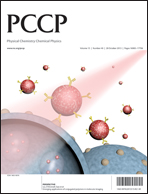From chemistry to mechanics: bulk modulus evolution of Li–Si and Li–Sn alloys via the metallic electronegativity scale†
Abstract
Toward engineering high performance anode alloys for Li-ion batteries, we proposed a useful method to quantitatively estimate the bulk modulus of binary alloys in terms of metallic electronegativity (EN), alloy composition and formula volume. On the basis of our proposed potential viewpoint, EN as a fundamental chemistry concept can be extended to be an important physical parameter to characterize the mechanical performance of Li–Si and Li–Sn alloys as anode materials for Li-ion batteries. The bulk modulus of binary alloys is linearly proportional to the combination of average metallic EN and atomic density of alloys. We calculated the bulk moduli of Li–Si and Li–Sn alloys with different Li concentrations, which can agree well with the reported data. The bulk modulus of Li–Si and Li–Sn alloys decreases with increasing Li concentration, leading to the elastic softening of the alloys, which is essentially caused by the decreased strength of constituent chemical bonds in alloys from the viewpoint of EN. This work provides a deep understanding of mechanical failure of Si and Sn anodes for Li-ion batteries, and permits the prediction of the composition dependent bulk modulus of various lithiated alloys on the basis of chemical formula, metallic EN and cell volume (or alloy density), with no structural details required.


 Please wait while we load your content...
Please wait while we load your content...